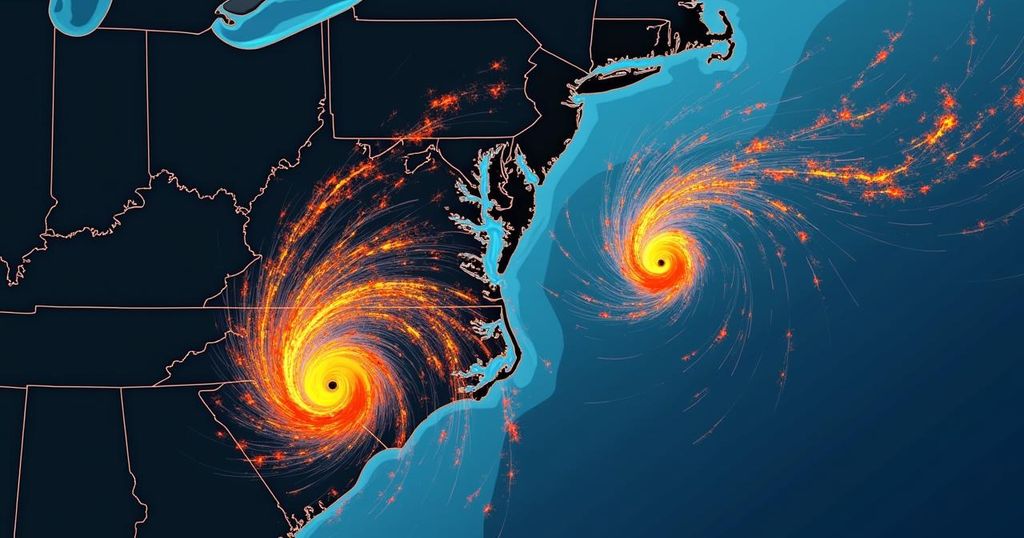Understanding the Impact of Hurricanes on Severe Weather: Insights from Hurricane Helene

Hurricane Helene has significantly affected the Southeastern United States, particularly Virginia and the Carolinas, causing widespread flooding and disruptions. Research by Majid Shafiee-Jood explores how hurricanes generate spinoff storms, the dynamics of flash floods, and the effectiveness of evacuation orders. Through developing a comprehensive hurricane evacuation order database, Shafiee-Jood and his team analyze public responses to hazardous weather information to enhance emergency management practices.
In the Southeastern United States, particularly affecting regions such as Virginia and the Carolinas, the impact of Hurricane Helene has been profound, leading to widespread road closures, persistent power outages, and devastating flood conditions. The severity of this situation has raised questions regarding the phenomena of spinoff storms generated by hurricanes originating further south. Majid Shafiee-Jood, a Research Assistant Professor in Civil and Environmental Engineering at the University of Virginia, elucidates the dynamics at play. Hurricanes are characterized as rapidly rotating storm systems packed with moisture, capable of producing significant rainfall that can swiftly escalate into flash floods. These floods differ from coastal flooding caused by storm surges, occurring swiftly within a few hours due to intense rainfall accumulation in specific regions. Flash floods, particularly in urban environments, tend to manifest because the highly developed landscapes limit the ground’s absorption capacity. In mountainous regions, the combination of steep slopes and saturated soils can lead to rapid flooding, often accompanied by mudslides or landslides, as currently observed in western North Carolina and parts of Virginia. When asked about the normalcy of such weather events, Shafiee-Jood noted that while alarming, these occurrences are not unprecedented. A comparison was made to Hurricane Michael in 2018, which similarly moved through the Southeast, producing significant rainfall in the process. Furthermore, Shafiee-Jood has pioneered the establishment of the first-ever hurricane evacuation order database. This database serves to analyze the effectiveness of evacuation orders issued by emergency management agencies in response to hurricanes. The research indicates a need for better understanding of public response to hazardous weather information, as evidenced by the various flash flood watches and warnings disseminated during hurricanes. His team seeks to quantify evacuation compliance when such critical alerts are issued. The ongoing research by Shafiee-Jood, along with contributions from colleagues such as Assistant Professor Negin Alemazkoor and former doctoral candidate Harsh Anand, emphasizes the significance of adopting a data-driven approach to understand evacuation behaviors during hazardous weather events. The implications of their work extend beyond academia, providing key insights for emergency management and public safety in the face of increasingly volatile weather patterns.
The article discusses the effects of Hurricane Helene and the subsequent weather phenomena experienced in Virginia and the Carolinas, specifically focusing on flash floods. It highlights the complexities of hurricane dynamics and their ability to generate localized severe weather, necessitating nuanced understanding and effective public safety measures. The work of Majid Shafiee-Jood, particularly in developing a database for hurricane evacuation orders, underscores the importance of assessing public response to weather alerts and evacuation directives.
In conclusion, hurricanes like Helene have far-reaching effects that can lead to severe weather events, such as flash floods, even in regions far from the storm’s immediate path. The research led by Majid Shafiee-Jood aims to improve understanding of these phenomena and enhance the efficacy of evacuation orders. Such efforts are crucial in safeguarding communities and mitigating the impacts of increasingly frequent and intense storms.
Original Source: news.virginia.edu






